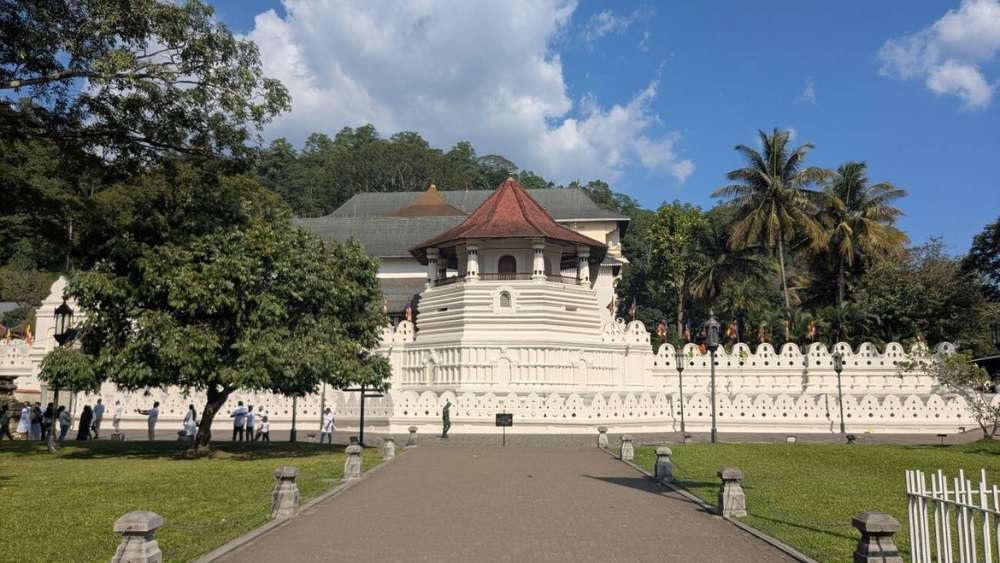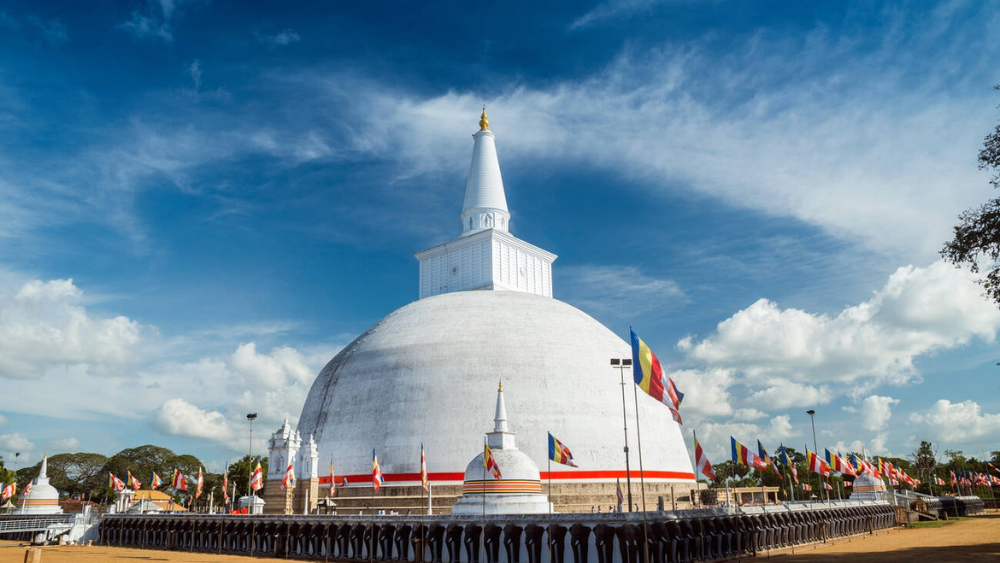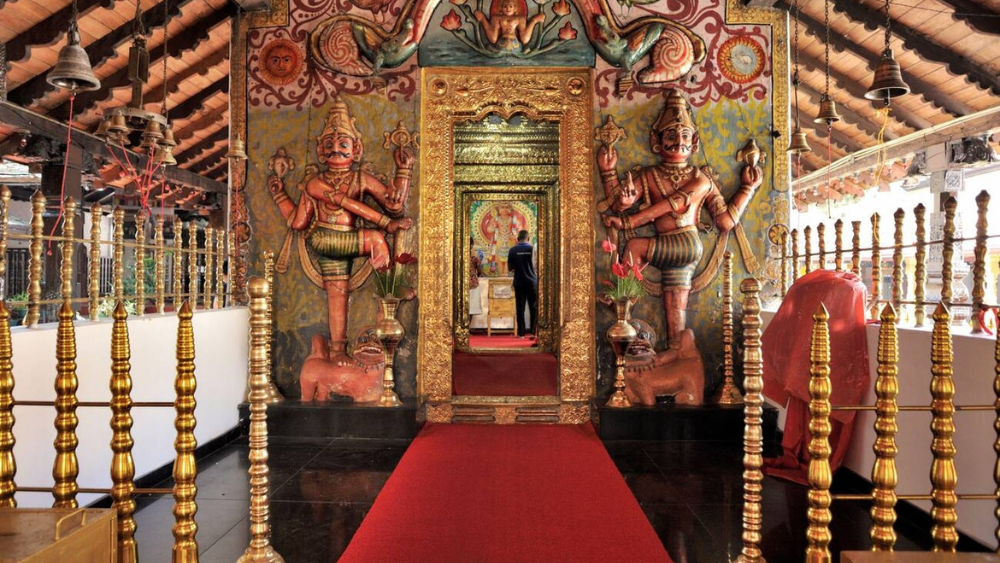Table of Contents
Best 5 Temples in Sri Lanka, rich in history and spirituality. Explore the unique temples, best time to visit, nearby attractions, and more. Sri Lanka, often referred to as the Pearl of the Indian Ocean, is a land steeped in spirituality and rich cultural heritage. With a history dating back over 2,500 years, the island nation is home to some of the most magnificent temples in the world. These temples are not just places of worship but also serve as architectural marvels, historical landmarks, and symbols of Sri Lanka’s deep-rooted Buddhist and Hindu traditions.
From the iconic Temple of the Sacred Tooth Relic in Kandy, which houses a revered relic of Lord Buddha, to the ancient rock temple of Dambulla, Sri Lanka’s temples captivate visitors with their intricate carvings, serene ambiance, and profound spiritual significance. Hindu temples, such as the Nallur Kandaswamy Kovil in Jaffna, showcase vibrant Dravidian architecture and are major pilgrimage sites for Tamil Hindus.
For travelers seeking cultural immersion, a visit to Sri Lanka’s temples provides insight into the country’s religious harmony and traditions. Whether you are drawn by the mysticism of centuries-old Buddhist stupas or the grandeur of Hindu shrines, Sri Lanka offers a temple experience unlike any other. From the coastal cities to the misty hills of the central highlands, every temple tells a story of devotion, resilience, and history.
History of Temples in Sri Lanka
Temples in Sri Lanka heritage dates back over 2,500 years, deeply intertwined with the arrival of Buddhism and the influence of Hinduism. The island’s spiritual and architectural evolution is reflected in its ancient stupas, rock-cut cave temples, and grand Hindu kovils, making it a significant destination for religious and cultural tourism.
The Arrival of Buddhism and the First Temples
The foundation of temples in Sri Lanka culture is closely linked to the introduction of Buddhism during the 3rd century BCE. According to historical records, Emperor Ashoka of India sent his son, Mahinda Thera, to Sri Lanka, where he converted King Devanampiya Tissa to Buddhism. This led to the construction of Mahavihara, the first Buddhist monastery in Anuradhapura, which became the heart of Theravāda Buddhism in Sri Lanka.
The Sri Maha Bodhi Tree in Anuradhapura, a sacred fig tree said to have been brought from India by Ashoka’s daughter Sanghamitta, remains one of the oldest living historical trees and is a revered site for Buddhists worldwide.
The Rise of Buddhist Stupas and Monasteries
Between the 3rd century BCE and the 10th century CE, Sri Lanka witnessed a golden era of temple construction. The kings of Anuradhapura and Polonnaruwa built massive stupas (dagobas), monasteries, and statues of Lord Buddha, some of which still stand today:
- Ruwanwelisaya Stupa (140 BCE) – Built by King Dutugemunu, this massive white stupa is considered one of the most sacred sites in Sri Lanka.
- Abhayagiri Monastery – A significant center for Buddhist learning that attracted scholars from across Asia.
- Jetavanaramaya Stupa – Once the tallest stupa in the world, showcasing the architectural brilliance of ancient Sri Lanka.
The Influence of Hinduism
Alongside Buddhism, Hinduism also played a crucial role in shaping Sri Lanka’s temple landscape. The Tamil communities in the north and east of the island built grand Hindu temples (kovils), heavily influenced by South Indian Dravidian architecture. The Nallur Kandaswamy Kovil in Jaffna, dedicated to Lord Murugan, is one of the most famous and spiritually significant Hindu temples in Sri Lanka.
The Koneswaram Temple in Trincomalee, believed to date back over 2,000 years, is another prominent Hindu shrine that was destroyed by Portuguese colonizers but later rebuilt in the 20th century.
Colonial Influence and Modern Temples
During the colonial era (16th–20th centuries), Sri Lanka experienced a decline in temple construction due to Portuguese, Dutch, and British rule. Many ancient temples were destroyed or abandoned, and religious practices were restricted. However, in the post-independence era, Sri Lanka has revived and restored many of its sacred sites, preserving its religious heritage.
Today, temples continue to serve as places of worship, pilgrimage, and cultural preservation. Annual religious festivals, such as the Esala Perahera in Kandy and Nallur Festival in Jaffna, showcase the deep devotion and spiritual significance of these temples in Sri Lankan society.
Best Time to Visit Temples in Sri Lanka
Sri Lanka is a year-round destination, but the best time to explore its temples depends on weather conditions and religious festivals:
- December to March: This is the ideal time to visit most temples as the weather is dry and pleasant.
- April and September: These months offer a balanced climate and fewer crowds, making it a good time for a peaceful spiritual experience.
- July and August: The Esala Perahera festival in Kandy, one of the grandest Buddhist festivals, takes place during this period, attracting thousands of pilgrims and tourists.
- October to November: While this period experiences occasional rainfall, it is a good time to witness temple rituals without large tourist crowds.
How to Reach Sri Lanka’s Famous Temples
Sri Lanka has a well-connected transportation system, making it easy for travelers to visit its iconic temples:
- By Air: Bandaranaike International Airport (Colombo) and Mattala Rajapaksa International Airport serve as the main gateways for international travelers.
- By Train: Sri Lanka’s scenic railway network connects major cities like Colombo, Kandy, and Jaffna, providing a picturesque journey to temples.
- By Road: A well-maintained road network with buses, taxis, and private car rentals allows travelers to explore temples conveniently.
- By Tuk-Tuk: A popular and affordable mode of transport, especially for short temple visits within cities.
Famous Temples in Sri Lanka
1. Temple of the Sacred Tooth Relic (Sri Dalada Maligawa) – Kandy

- How to Reach: Located in Kandy, it is easily accessible by train, bus, and private vehicle from Colombo (approx. 3 hours).
- Best Time to Visit: During the Esala Perahera festival (July–August) for grand processions.
- Highlights: Ornate golden roof, daily poojas (prayer ceremonies), and stunning Kandy Lake surroundings.
- Description: The Temple of the Sacred Tooth Relic (Sri Dalada Maligawa) in Kandy, is one of the most revered Buddhist temples in the world. It houses the sacred tooth relic of Lord Buddha, making it a major pilgrimage site for Buddhists. The temple, built within the royal palace complex, showcases stunning Kandyan architecture with intricate carvings and golden decorations. The Esala Perahera festival, held annually, features a grand procession honoring the relic. The temple’s spiritual significance, combined with its rich history and cultural heritage, makes it a must-visit destination for both devotees and travelers in Sri Lanka.
2. Ruwanwelisaya Stupa – Anuradhapura

- How to Reach: Accessible by train or bus from Colombo to Anuradhapura (approx. 4 hours).
- Best Time to Visit: Early morning or late evening for a peaceful ambiance.
- Highlights: Massive white stupa, ancient carvings, and spiritual ambiance.
- Description: Ruwanwelisaya Stupa, located in Anuradhapura, Sri Lanka, is one of the most sacred and revered Buddhist stupas in the world. Built in 140 BCE by King Dutugemunu, this magnificent structure symbolizes Sri Lanka’s deep Buddhist heritage. The stupa stands 103 meters tall with a massive white dome, representing the purity of Buddhism. It enshrines sacred relics of Lord Buddha, making it an important pilgrimage site. The surrounding complex features intricate carvings, statues, and a serene atmosphere for meditation. Ruwanwelisaya remains a spiritual and architectural marvel, drawing thousands of devotees and tourists each year.
3. Nallur Kandaswamy Temple – Jaffna

- How to Reach: Flight or train to Jaffna from Colombo, followed by a short tuk-tuk ride.
- Best Time to Visit: During the Nallur Festival (August–September).
- Highlights: Towering golden gopuram, elaborate rituals, and vibrant cultural celebrations.
- Description: Nallur Kandaswamy Temple is one of the most revered Hindu temples in Sri Lanka, located in Jaffna. Dedicated to Lord Murugan, this grand Dravidian-style temple has a history dating back to the 10th century, though the current structure was rebuilt in 1734 during Dutch colonial rule. The temple features an iconic golden gopuram (tower), intricate carvings, and a sacred inner sanctum. It is a major pilgrimage site, especially during the Nallur Festival, a 25-day celebration filled with rituals, chariot processions, and traditional music. Visitors must follow a strict dress code, with men required to remove shirts before entering.
4. Dambulla Cave Temple – Dambulla

- How to Reach: Bus or car from Colombo (approx. 4 hours).
- Best Time to Visit: Morning or late afternoon to avoid crowds.
- Highlights: Five cave temples, over 150 Buddha statues, and scenic hilltop views.
- Description: Dambulla Cave Temple, also known as the Golden Temple of Dambulla, is a UNESCO World Heritage Site and one of Sri Lanka’s most sacred Buddhist temples. Dating back to the 1st century BCE, it consists of five caves adorned with over 150 Buddha statues and intricate murals depicting Buddhist teachings. Located in central Sri Lanka, the temple sits atop a 160-meter-high rock, offering breathtaking panoramic views. It remains an active monastery and a major pilgrimage site. Visitors are drawn to its spiritual ambiance, artistic heritage, and historical significance, making it a must-visit destination in Sri Lanka.
5. Kataragama Temple

- How to Reach? 6-7 hours from Colombo by road.
- Best Time to Visit: July-August for the Kataragama Festival.
- Highlights: Religious diversity, lively processions, and spiritual energy.
- Description: Kataragama Temple is one of Sri Lanka’s most revered religious sites, attracting Hindu, Buddhist, and indigenous Vedda devotees. Located in the town of Kataragama in the southern region of the country, the temple is dedicated to Lord Murugan (Skanda), the Hindu god of war. The temple complex houses a sacred stupa, shrines, and a vibrant atmosphere filled with prayers and rituals. Pilgrims from across Sri Lanka undertake foot pilgrimages to seek blessings. The best time to visit is during the Kataragama Festival in July, featuring grand processions, fire-walking, and devotional music, making it a deeply spiritual experience.
Nearby Attractions
- Sigiriya Rock Fortress: An ancient rock citadel near Dambulla with stunning frescoes and panoramic views.
- Kandy Lake: A tranquil spot near the Temple of the Tooth Relic, ideal for a peaceful walk.
- Jaffna Fort: A historical landmark near Nallur Kandaswamy Temple showcasing colonial architecture.
- Mihintale: The birthplace of Buddhism in Sri Lanka, featuring monasteries and stupas.
Luxury Hotels Near Sri Lanka’s Temples
- Cinnamon Citadel (Kandy): A luxurious riverside hotel near the Temple of the Tooth Relic.
- Uga Ulagalla (Anuradhapura): A heritage boutique resort close to Ruwanwelisaya Stupa.
- Jetwing Jaffna: A premium hotel offering comfort near Nallur Kandaswamy Temple.
- Heritance Kandalama (Dambulla): A five-star eco-resort with breathtaking views near Dambulla Cave Temple.
Conclusion
In addition to being houses of worship, Sri Lanka’s temples serve as representations of the nation’s rich spiritual heritage, rich history, and diverse culture. Every temple, from the venerable Kataragama Temple to the magnificent Temple of the Tooth Relic, provides a different kind of spiritual experience and a window into the religious harmony of the island. A visit to these temples is an enlightening experience, whether you are seeking blessings, admiring historic architecture, or becoming immersed in local customs. Choose the ideal times of year to come in order to take in the magnificent festivities and customs that will make your trip genuinely unforgettable. Discover, ponder, and enjoy the peace of Sri Lanka’s holy places.
FAQs
Which are the most famous temples to visit in Sri Lanka?
Some of the most famous temples in Sri Lanka include the Temple of the Tooth Relic in Kandy, Kataragama Temple, Dambulla Cave Temple, Gangaramaya Temple in Colombo, and Kelaniya Raja Maha Vihara.
What is the best time to visit temples in Sri Lanka?
The best time to visit is during the dry season from December to April. Visiting during religious festivals like Esala Perahera (July/August) offers a unique experience.
Are there any dress codes to follow while visiting temples in Sri Lanka?
Yes, visitors must wear modest clothing that covers shoulders and knees. Shoes and hats should be removed before entering temple premises.
How can I reach the famous temples in Sri Lanka?
Most temples are accessible by road, with major cities like Colombo and Kandy well-connected via buses, trains, and taxis. Some temples, like the Temple of the Tooth, are easily reachable from major tourist hubs.
Do Sri Lankan temples charge an entry fee?
While many Buddhist temples are free, some popular ones like the Temple of the Tooth Relic may charge a small entrance fee for maintenance and preservation.
Can non-Buddhists visit temples in Sri Lanka?
Yes, Sri Lankan temples welcome visitors of all faiths. However, it is important to respect local customs, follow temple rules, and maintain silence within the premises.

